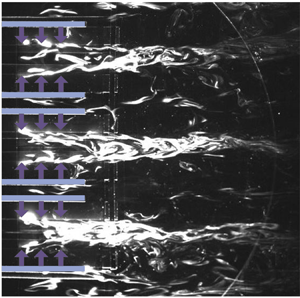Crossref Citations
This article has been cited by the following publications. This list is generated based on data provided by
Crossref.
Yu, Jianing
Fan, Dewei
Noack, Bernd. R.
and
Zhou, Yu
2021.
Genetic-algorithm-based artificial intelligence control of a turbulent boundary layer.
Acta Mechanica Sinica,
Vol. 37,
Issue. 12,
p.
1739.
Ji, Yong
Yao, Jie
Hussain, Fazle
and
Chen, Xi
2021.
Vorticity transports in turbulent channels under large-scale control via spanwise wall jet forcing.
Physics of Fluids,
Vol. 33,
Issue. 9,
Wong, Chi Wai
Cheng, Xiaoqi
Fan, Dewei
Li, Wenfeng
and
Zhou, Yu
2021.
Friction drag reduction based on a proportional-derivative control scheme.
Physics of Fluids,
Vol. 33,
Issue. 7,
Wu, Zhi
and
Choi, Haecheon
2021.
Modification of flow behind a circular cylinder by steady and time-periodic blowing.
Physics of Fluids,
Vol. 33,
Issue. 11,
Li, Bo
Meng, Xuanshi
Yin, Shiqing
Hui, Weiwei
and
Li, Huaxing
2022.
Flow Separation Control over an Airfoil Using Plasma Co-Flow Jet.
AIAA Journal,
Vol. 60,
Issue. 4,
p.
2195.
Ahmed, Essam N.
Naqvi, Sahrish B.
Buda, Lorenzo
and
Bottaro, Alessandro
2022.
A Homogenization Approach for Turbulent Channel Flows over Porous Substrates: Formulation and Implementation of Effective Boundary Conditions.
Fluids,
Vol. 7,
Issue. 5,
p.
178.
Chen, Xiaonan
Iwano, Koji
Sakai, Yasuhiko
and
Ito, Yasumasa
2022.
Effect of artificial large-scale structures on bursting phenomenon in turbulent boundary layer.
Physics of Fluids,
Vol. 34,
Issue. 8,
Umair, Mohammad
Tardu, Sedat
and
Doche, Olivier
2022.
Reynolds stresses transport in a turbulent channel flow subjected to streamwise traveling waves.
Physical Review Fluids,
Vol. 7,
Issue. 5,
Wang, Yu-Shuai
Wu, Bin
Gao, Chao
Yuan, Xian-Shi
Zhang, Yi-Xing
Wang, Na
Xu, Ze-Yang
Li, Yue-Qiang
Wang, Yu-Ling
and
Hao, Dong-Dong
2022.
Lagrangian analysis of the flow induced by a dielectric barrier discharge plasma actuator array under burst mode actuation.
AIP Advances,
Vol. 12,
Issue. 11,
Varacalli, Michael
Khanjari, Hossein
Hanson, Ronald
and
Lavoie, Philippe
2022.
Temporal Response of the Laminar Boundary Layer to Step Input Plasma Vortex Generators of Varying Streamwise Extent.
Zhang, X.
Wong, C. W.
Cheng, X. Q.
and
Zhou, Y.
2022.
Dependence of skin-friction reduction on the geometric parameters of blowing jet array.
Physics of Fluids,
Vol. 34,
Issue. 10,
Khanjari, Hossein
Hanson, Ronald E.
and
Lavoie, Philippe
2022.
Laminar Boundary-Layer Response to Step Input by an Array of Plasma Actuators.
AIAA Journal,
Vol. 60,
Issue. 11,
p.
6328.
Castellanos, Rodrigo
Michelis, Theodoros
Discetti, Stefano
Ianiro, Andrea
and
Kotsonis, Marios
2022.
Reducing turbulent convective heat transfer with streamwise plasma vortex generators.
Experimental Thermal and Fluid Science,
Vol. 134,
Issue. ,
p.
110596.
Zong, H.
Su, Z.
Liang, H.
and
Wu, Y.
2022.
Experimental investigation and reduced-order modeling of plasma jets in a turbulent boundary layer for skin-friction drag reduction.
Physics of Fluids,
Vol. 34,
Issue. 8,
Ruby, Marius
and
Foysi, Holger
2022.
Active control of compressible channel flow up to Mab=3 using direct numerical simulations with spanwise velocity modulation at the walls.
GAMM-Mitteilungen,
Vol. 45,
Issue. 1,
Hui, Weiwei
Meng, Xuanshi
Li, Huanxing
and
Liu, Feng
2022.
Flow induced by a pair of plasma actuators on a circular cylinder in still air under duty-cycle actuation.
Physics of Fluids,
Vol. 34,
Issue. 12,
Ma, Rui
Gao, Zheng-hong
Lu, Lian-shan
and
Chen, Shu-sheng
2022.
Skin-friction drag reduction by local porous uniform blowing in spatially developing compressible turbulent boundary layers.
Physics of Fluids,
Vol. 34,
Issue. 12,
SU, Zhi
ZONG, Haohua
LIANG, Hua
LI, Jun
XIE, Like
LIU, Xuecheng
KONG, Weiliang
and
ZHENG, Borui
2023.
Minimizing airfoil drag at low angles of attack with DBD-based turbulent drag reduction methods.
Chinese Journal of Aeronautics,
Vol. 36,
Issue. 4,
p.
104.
Serpieri, Jacopo
Hehner, Marc T.
Pasch, Saskia
Gatti, Davide
and
Kriegseis, Jochen
2023.
Introducing a Multi-Modal Plasma Actuator for Turbulent Flow Actuation.
AIAA Journal,
Vol. 61,
Issue. 8,
p.
3707.
LI, Yueqiang
WU, Bin
GAO, Chao
ZHENG, Haibo
WANG, Yushuai
and
YAN, Rihua
2023.
Turbulent boundary layer control with DBD plasma actuators.
Plasma Science and Technology,
Vol. 25,
Issue. 4,
p.
045508.



